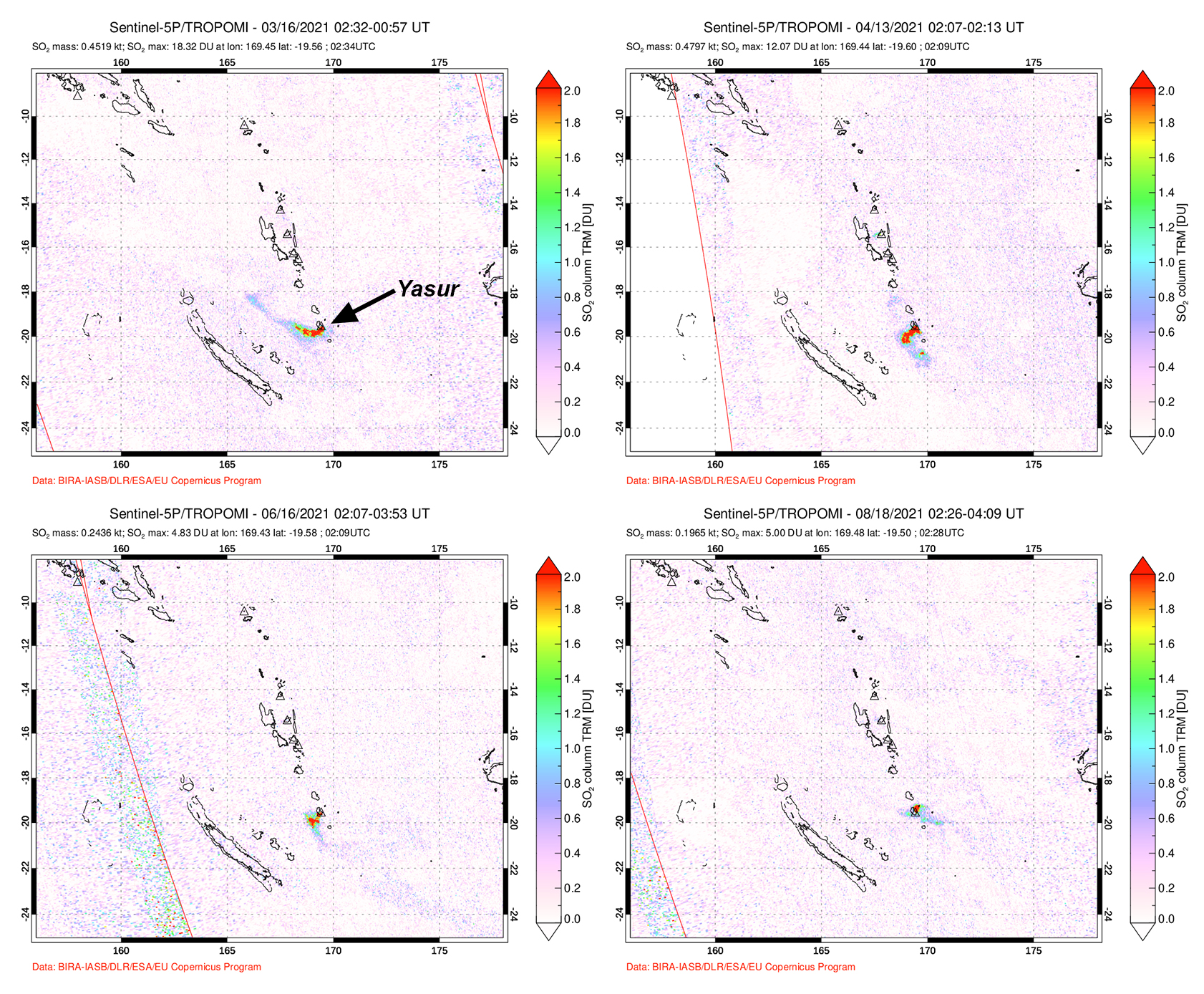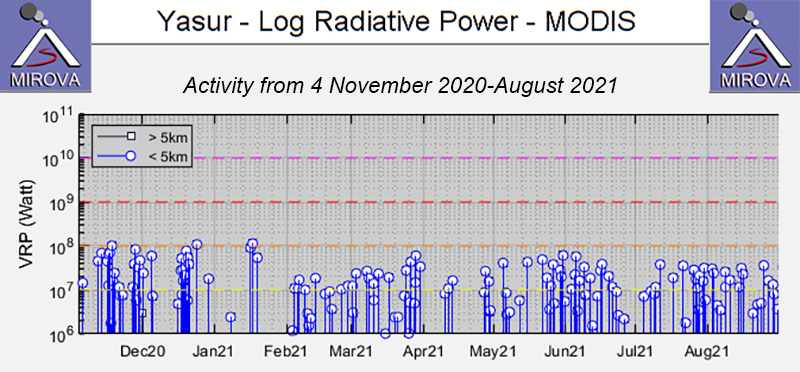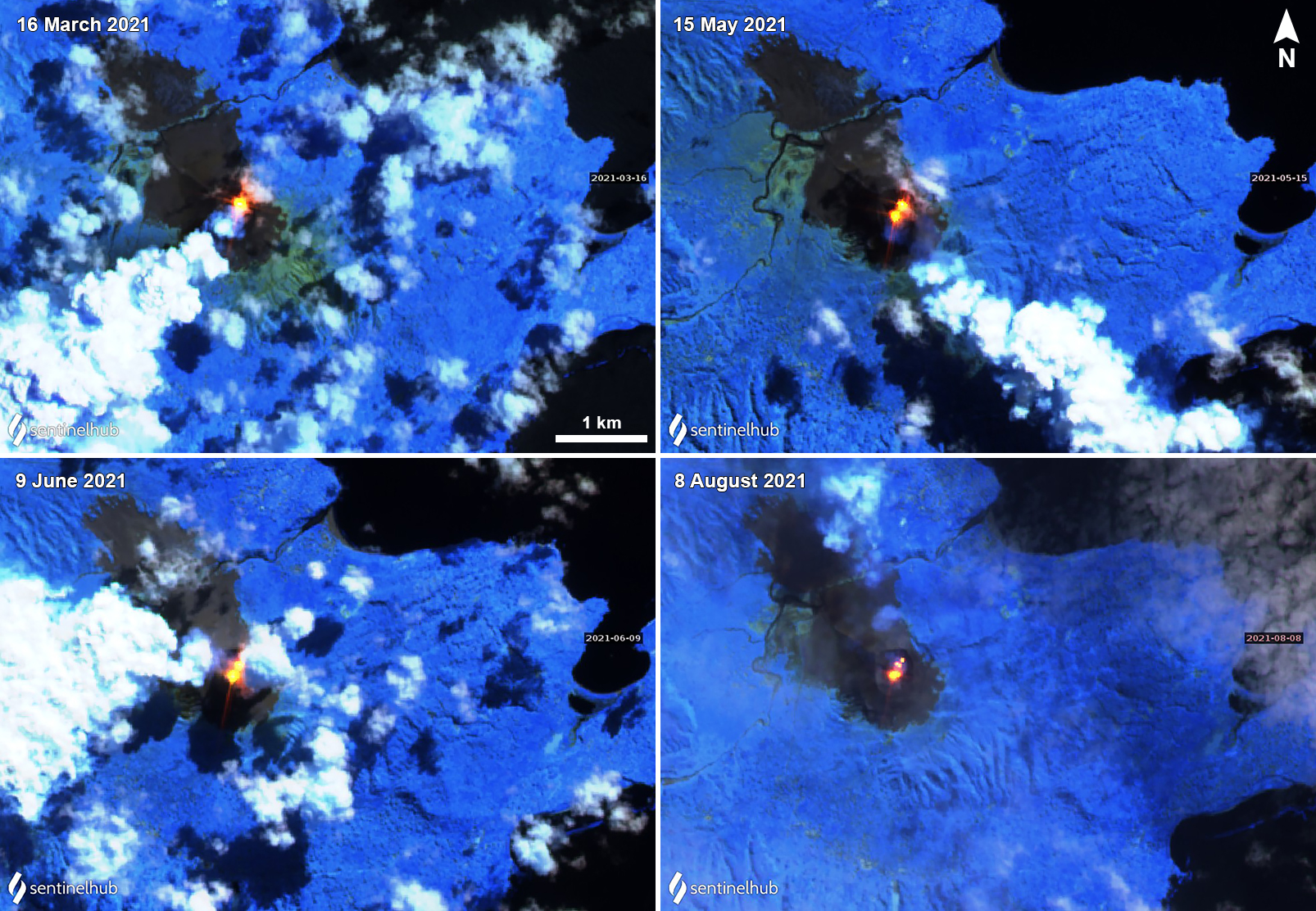Report on Yasur (Vanuatu) — September 2021
Bulletin of the Global Volcanism Network, vol. 46, no. 9 (September 2021)
Managing Editor: Benjamin Andrews.
Edited by Kadie L. Bennis.
Yasur (Vanuatu) Gas-and-ash explosions, SO2 plumes, and thermal anomalies during March-August 2021
Please cite this report as:
Global Volcanism Program, 2021. Report on Yasur (Vanuatu) (Bennis, K.L., and Andrews, B., eds.). Bulletin of the Global Volcanism Network, 46:9. Smithsonian Institution. https://doi.org/10.5479/si.GVP.BGVN202109-257100
Yasur
Vanuatu
19.532°S, 169.447°E; summit elev. 361 m
All times are local (unless otherwise noted)
Yasur is located at the SE tip of Tanna Island and contains a 400-m-wide summit crater within the small Yenkahe caldera. The current eruption has been ongoing since at least 1774 and has been characterized by Strombolian and Vulcanian activity. More recent activity has consisted of Strombolian activity and gas-and-ash emissions (BGVN 46:04), which continues during this reporting period of March through August 2021. Information primarily comes from monthly bulletins of the Vanuatu Meteorology and Geo-Hazards Department (VMGD) and various satellite data. The Volcano Alert Level remained at a 2 (on a scale of 0-4) during this reporting period.
VMGD reported that seismic data and recent visual observations confirmed ongoing explosions and gas-and-ash emissions during the reporting period. Sulfur dioxide emissions occasionally accompanied those explosions and were measured using the Sentinel-5P/TROPOMI satellite instrument for multiple days each month from March through August (figure 81). The density and drift direction varied.
Intermittent thermal anomalies recorded by the MIROVA (Middle InfraRed Observation of Volcanic Activity) system during March through August were of moderate intensity, though brief periods of low activity were observed during April and late June to early July (figure 82). A total of twelve thermal alerts were detected by the MODVOLC thermal algorithm on 1 (1) and 28 (2) March, 11 April (1), 26 May (1), 3 (1) and 11 (1) June, 28 (1) and 30 (1) July, and 10 (1) and 15 (2) August. On clear weather days, as many as three thermal anomalies at the summit crater (occupying both the N and S vents) were also seen in Sentinel-2 infrared satellite images (figure 83).
Geological Summary. Yasur has exhibited essentially continuous Strombolian and Vulcanian activity at least since Captain Cook observed ash eruptions in 1774. This style of activity may have continued for the past 800 years. Located at the SE tip of Tanna Island in Vanuatu, this pyroclastic cone has a nearly circular, 400-m-wide summit crater. The active cone is largely contained within the small Yenkahe caldera, and is the youngest of a group of Holocene volcanic centers constructed over the down-dropped NE flank of the Pleistocene Tukosmeru volcano. The Yenkahe horst is located within the Siwi ring fracture, a 4-km-wide open feature associated with eruption of the andesitic Siwi pyroclastic sequence. Active tectonism along the Yenkahe horst accompanying eruptions has raised Port Resolution harbor more than 20 m during the past century.
Information Contacts: Geo-Hazards Division, Vanuatu Meteorology and Geo-Hazards Department (VMGD), Ministry of Climate Change Adaptation, Meteorology, Geo-Hazards, Energy, Environment and Disaster Management, Private Mail Bag 9054, Lini Highway, Port Vila, Vanuatu (URL: http://www.vmgd.gov.vu/, https://www.facebook.com/VanuatuGeohazardsObservatory/); MIROVA (Middle InfraRed Observation of Volcanic Activity), a collaborative project between the Universities of Turin and Florence (Italy) supported by the Centre for Volcanic Risk of the Italian Civil Protection Department (URL: http://www.mirovaweb.it/); Hawai'i Institute of Geophysics and Planetology (HIGP) - MODVOLC Thermal Alerts System, School of Ocean and Earth Science and Technology (SOEST), Univ. of Hawai'i, 2525 Correa Road, Honolulu, HI 96822, USA (URL: http://modis.higp.hawaii.edu/); NASA Global Sulfur Dioxide Monitoring Page, Atmospheric Chemistry and Dynamics Laboratory, NASA Goddard Space Flight Center (NASA/GSFC), 8800 Greenbelt Road, Goddard, Maryland, USA (URL: https://so2.gsfc.nasa.gov/); Sentinel Hub Playground (URL: https://www.sentinel-hub.com/explore/sentinel-playground).




